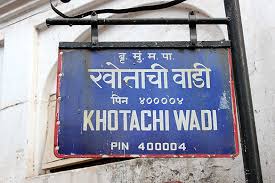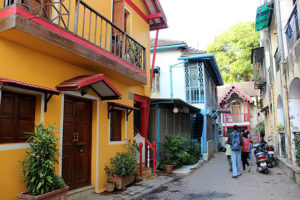
Today when we look at the busy streets of Bombay, India, we are greeted by people that represent every social strata, race, religion, community and even the economic spectrum. Each one has their own life to live, complicated by their trysts with the lives of others through the virtue of inter-dependence. Here each one tries to make enough money to feed his family on a peninsula that is co-incidentally the Financial and Bollywood capital of the seventh largest nation in the world.
But though this city thrives on the notion of “Clarity in Chaos”, there are certain pockets tucked neatly beyond easy reach of the modern day developers and where not only time but even the lives of the people associated with these localities have remained untouched by the pacing heartbeats and melodious honking of cars that beckon the extra rupee. One such classic and Romantic example is Kotachiwadi, a quaint Portuguese hamlet in a robust city.
To understand the Portuguese connection in what was always assumed to be a British Trading Hub, one needs to go back to the 1500’s when Francisco de Almeida, the First Portuguese Viceroy of Goa to Portugal, piloted his ships south from the coast of Gujarat in search of Panjim, whose harbours made enabled it to be baptized as the “Lisbon of the East”; the ships landed on a group of seven islands which he named, in 1508 – “Bom Bahia” meaning Good Bay for its natural harbours. It was only with the marriage treaty of Catherine of Braganza of Portugal with King Charles II of England in 1661 that the Bom Bahia Islands were given to the English who Anglicized it to Bombay.
Khotachiwadi is one such legacy of a Portuguese Heritage Village in Girgaon, Mumbai, India. The houses here generally conform to the old-Portuguese style architecture. It was founded in the late 18th century by Khot, a Pathare prabhu, who sold plots of land to local East Indian families working with the British East India Company. Thus the term Kotachi Wadi, meaning locality of Khot.
Until the first half of the 17th Century, maybe even until the 1880s, only 11 Portuguese families lived in Girgaum, spread under the palm grove’s shade and around the gardens. Today, Khotachiwadi’s lanes, family names, architectural forms, social, cultural and culinary traditions continue to perpetuate the customs and habits from days that have long gone.
Many of the residents believe that Khotachiwadi represents Bombay, an era of Architectural beauty mixed with Art Deco and Portuguese styles, paving its way to become a Heritage Village and making a mark in a world full of structures reaching new heights, quite literally.

Of the 65 buildings that made up the original hamlet of Khotachiwadi, only 27 stand today. The rest have fallen prey to developers and builders fuelled by a mad rush for prime property in South Bombay, enabling a mode of redevelopment that has scant respect for aesthetics of this historic hamlet. Talking about the decline of Khotachiwadi, Ferreira, a fashion designer, says: “The periphery of Khotachiwadi has been destroyed, though the core still remains. Now, we’re fighting to save those few existing bits. The fact that the roads are too narrow to allow for a skyscraper to come up here only helps our case towards saving this treasure.”
Pushing for Conservation and appropriate Heritage Status from the Government to protect this hamlet from greedy and powerful builder lobbies, Kaiwan Mehta, an architect and a founder-director of the architectural research initiative Arbour, says: “These spaces have grown over a period of time. There are memories and life practices that are embedded in these spaces. We will have to strive to allow for more organic change. And that certainly entails resisting any mode of development which is enforced upon the people of such spaces without taking into account any of the factors that affect their lives and in turn, the city itself”.

With a city like Bombay that is growing by the day on a peninsula like Hong Kong and where space is a luxury, there will be persistent battles between the preservationists and futurists who claim to believe in a Bombay of Tomorrow that banishes yesterday and today into oblivion. It is however, our past and present that make our tomorrow and its respect and protection is key for the learnings of future generations.